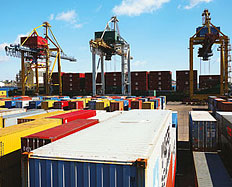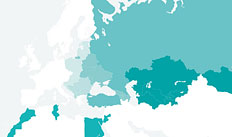COUNTRY ASSESSMENTS
Armenia
HIGHLIGHTS OF THE PAST YEAR
- The authorities have continued to deregulate the economy and establish frameworks for competition and improved governance. Reforms of business regulations, property rights and public inspections have been introduced, competition legislation was improved and a law on conflict of interest was adopted.
- A new mining code was approved. The new code is expected to improve the investment environment in the sector and lead to greater revenues over time, as taxation of the sector will be more closely tied to the sale of ores rather than reserves.
- The authorities continue to implement policies to stimulate capital market development and reduce dollarisation. The central bank continued to tighten the regulatory framework to encourage the use of local currency by obliging banks to keep required reserves in AMD. Regulations were adopted to enable issuance of foreign currency bonds by local enterprises and banks.
KEY PRIORITIES FOR 2013
- It is critical to make a definitive breakthrough in the strengthening of the business environment. The many recent reforms have to be implemented in letter and spirit, and the review of regulations should continue to ensure any unnecessary obstacles are eliminated.
- More needs to be done to facilitate domestic and international trade. Improvement of the transportation and communications infrastructure would aid development of export-oriented sectors and reduce the high implicit transaction costs.
- The authorities should persevere with developing local capital markets. The ambitious de-dollarisation agenda should be supported by a consistent shift of the monetary policy framework from de facto peg to inflation targeting. The upcoming pension reform should serve as a strategic opportunity to develop domestic markets for government securities, bank deposits and equities through an active institutional investor base providing steady demand for long-term investments.
MACROECONOMIC PERFORMANCE
The pace of recovery from the crisis has accelerated. After increasing by 4.7 per cent in 2011, output growth increased to 6.6 per cent year-on-year in the first half of 2012. Mining and manufacturing remain the main drivers of growth. The largely unreformed agricultural sector has also recovered from the slump of 2010 due to more favourable weather conditions and higher remittances. The construction sector has shown the first signs of recovery since the 2009 crisis. The authorities have continued fiscal consolidation to maintain sovereign debt at a sustainable level, under an IMF-supported programme. The economy continues to benefit from large remittance inflows and substantial official financing. Credit growth has been strong, reflecting a generally low level of financial intermediation. Since November 2011 inflation has remained within the central bank's target range of 4+/-1.5 per cent. External imbalances have been reduced although the current account deficit remains high at around 11 per cent of GDP.
Immediate economic prospects are clouded by the uncertain global environment. Maintaining output growth of around 4 per cent in 2012 and 2013 would require remittances and demand from international partners, in particular Russia, to remain buoyant, and reasonably high world prices on main commodity exports. Inflation is expected to remain in the central bank's target range. Recent depreciation of the dram should help support export competitiveness.
Long-term growth prospects remain uncertain. As a landlocked country with limited access to neighbouring markets, Armenia requires significant reforms of its business environment, increased competition and improved physical infrastructure. The country's relatively monopolised economy remains overly dependent on low value added commodity exports, which makes it vulnerable to negative shocks suffered by its trading partners.
MAJOR STRUCTURAL REFORM DEVELOPMENTS
The authorities have continued to implement various measures to improve the business environment. In addition to pursuing an action plan to improve the business environment and governance, in June 2011 the authorities embarked on a "Regulatory Guillotine." Modernisation of the tax administration is ongoing, with the support of the World Bank. The aims of this programme are to increase voluntary tax compliance, reduce tax evasion, reduce compliance costs and increase administrative efficiency. A green channel was introduced by customs at the beginning of 2012, leading to a considerable reduction in the time and complexity of customs formalities.
A number of positive changes in the area of competition legislation and policy have taken place. Legislative changes introduced in the course of 2011-12 included amendments and additions to the current laws (including introduction of leniency measures for participants in the anti-competitive agreements), specification of the fine amounts, reinforcement of sanction measures and specification of separate notions. In particular, anti-competitive agreements were divided into horizontal, vertical and mixed, and a qualitative indicator for dominant position in the market was introduced. In terms of enforcement, the State Commission for the Protection of Economic Competition (SCPEC) has further improved its efficiency, which is evident from the significant increase in the number of cases reviewed and decisions reached in 2011 in comparison with 2009. At the same time none of the decisions challenged in the court in 2011 were overturned. Since last year, SCPEC has also intervened in the activities of dominant fuel companies, pharmaceutical companies and medical centres.
Mining legislation has moved towards international standards. In November 2011 parliament approved amendments to the mining code. The new code, to be applied to most types of natural resources except for oil, gas, water and radioactive materials, specifies principles and rules of usage of sub-surface resources and their environmental protection. It streamlines the licensing process, therefore decreasing transaction costs for investors. The transition from exploration to production has been made more transparent and stable as the new code clearly defines the rights and obligations of mining investors and operators. The taxation of minerals was made more transparent, competitive and simpler. The new law is closer to international best practice and is expected to improve the investment environment in the sector and boost government revenues. Compared with the previous legislation, taxation of the sector will be tied more closely to the sale of ores rather than reserves.
The authorities are pursuing policies to encourage exports. In December 2011 the government adopted an export-promotion strategy, targeting several sectors in which Armenia has a comparative advantage. A dedicated team was established in the Ministry of Economy with the resources and targets needed to ensure results. Free economic zones were also established to help develop the agricultural sector, high-tech industry and trade. The zone in Zvartnots airport, to operate in cooperation with Argentine Corporation America, will facilitate the export of fresh fruits and vegetables. Another zone, to be based at the Mars plant, is expected to develop industry using innovative technologies. The government also agreed to create a free economic zone with Iran for joint investments in the border region.
However, the preferential tax treatments offered by these zones may pose risks to the government's tax base. In 2011‑13, Armenia is expected to receive €32 million of assistance from the European Union to help prepare for the introduction of a free trade agreement with the EU and harmonisation of Armenia's laws and regulations with EU standards.
Ongoing reforms, in particular in the pension system, should support further de-dollarisation and further development of the local capital market. The Central Bank of Armenia (CBA) has continued to raise the proportion of required bank reserves that has to be kept in the dram, in order to increase banks' demand for local currency. This measure has had limited impact on deposit or loan dollarisation. In fact, foreign currency corporate loans have continued to expand both in absolute terms and as a share of the total. The EBRD launched a technical cooperation project supporting a broader IMF initiative to enhance the central bank's capacities to control inflation, as a lower inflation level and reduced volatility would help strengthen trust, and thus savings, in the local currency. The voluntary contributions into the second pillar of the pension system started in 2011 and will become mandatory in 2013. Although a large portion of the initial pension fund investments may be invested abroad because domestic financial markets are undeveloped, domestic investments are expected to increase over time and will help develop the country's debt and equity markets. In June 2012 the authorities adopted regulations allowing issuance of domestic bonds in foreign currencies. Although it may be initially utilised to place dollar‑denominated bonds, the new law may help create the infrastructure needed for ultimate issuance of securities in the local currency.







